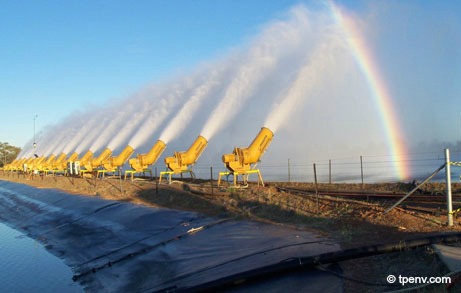Hydraulic fracturing, or fracking, is the process of injecting pressurized water, chemicals, and sand into the ground to extract shale oil and natural gas. While fracking has transformed energy production in the U.S., it requires a lot of water and thus creates a lot of wastewater, which must be treated and disposed of safely. In this video interview, Triplepoint’s resident expert, western regional manager Tom Daugherty, gives the lowdown on fracking wastewater and how frac ponds can be economically upgraded with Ares Aeration®. Read below for highlights and links to more information.
Where does fracking wastewater come from?
In order to create a pathway to release shale oil and natural gas, drillers inject a well with 2.5 to 5 million gallons of water that’s been mixed with sand and chemicals. The water that comes back out (flowback and produced water) contains salts, hydrocarbons, metals, chemicals, and naturally occurring radioactive materials. The EPA considers this wastewater potentially harmful and it needs to be handled and disposed of appropriately.
What are the challenges for this type of water?

Because the EPA bans the treatment of fracking wastewater at publicly owned treatment works, drillers determine their own wastewater treatment solutions.
What are the benefits of adding aeration to frac ponds?
In his article, Advanced Aeration in Hydraulic Fractured Water Impoundments, our own Tom Daugherty explains the benefits of adding dissolved oxygen to frac ponds. Aeration
- oxidizes sulfide reducing bacteria, which mitigates hydrogen sulfide odors
- stabilizes pH
- helps to strip hydrocarbon gases and volatile compounds
- oxidizes metals so they can be filtered or settled
- prevents sludge buildup and surface matting
- enhances evaporation
Fracs ponds at a drill site in Utah that were upgraded with Triplepoint’s aerators demonstrated a significant reduction in BTEX chemicals: after fourteen days, benzene was reduced by 54 percent; toluene by 39 percent, and xylene by 52 percent.
What are the potential cost savings?
According to Sourcewater, an online marketplace for energy industry water sourcing and disposal, water management accounts for more than 50 percent of a well’s operating cost. Treating onsite for reuse reduces piping, trucking, and water sourcing costs, at an estimated savings of over $150,000 per well. In addition, access to water can be a limiting factor, so treating for reuse can ensure water is available to continue drilling.
What is the environmental impact of treating fracking wastewater?

Still, fracking is not the best use for pristine drinking water supplies, especially in regions with drought and water shortages. The less taken out of the ground, the better.
According to a scientific paper in Fuel, “A review of the issues and treatment options for wastewater from shale gas extraction by hydraulic fracturing,” partial treatment and reuse is the preferred method of water and wastewater management.
Onsite treatment for reuse not only saves money, it also demonstrates responsibility to the environment and may help improve the perception of fracking.
Benefits of Ares aeration in frac ponds
Triplepoint’s lagoon aerators, which feature patented Double Bubble Technology™, combine the mixing capabilities of coarse bubbles with the superior oxygenation of fine bubbles in a modular, portable unit. Ares diffusers provide:
- Robust mixing—Coarse bubbles are released at the bottom of the static tube, creating a draft that pulls water and liquefied organic matter up from the floor, thoroughly churning and circulating the entire water column to keep solids in suspension and prevent sludge accumulation.
- Efficient aeration—Fine bubble diffusers surround the static tube maximize oxygen transfer efficiency while minimizing energy consumption.
- Easy installation—Self-weighted and portable, Ares aerators are quickly installed from the surface with no system downtime.
- Low maintenance—Ares have no submerged moving parts to clog or malfunction. The anti-fouling design, with self-checked diffusers and self-cleaning EPDM membranes, means maintenance is kept to a minimum.
- Energy efficiency—Ares aerators are 30–50% more energy efficient than surface aerators, reducing energy demands and expense.
To learn more about how Ares can treat fracking wastewater for reuse, saving thousands of dollars in water sourcing and transportation costs, request a free quote.

